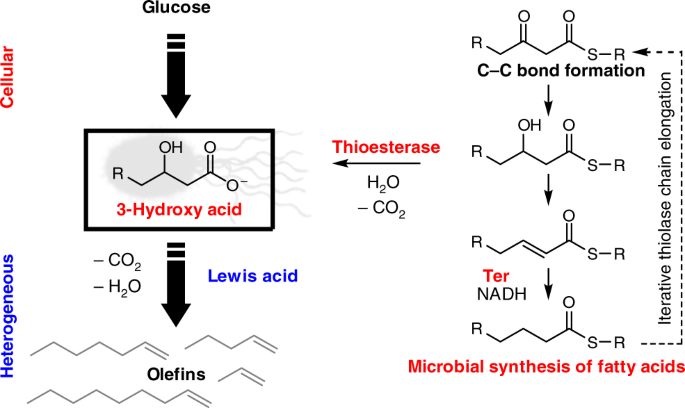2021-11-23 アメリカ合衆国・バッファロー大学

・ バッファロー大学とカリフォルニア大学バークレー校(UCB)が、遺伝子組み換え微生物とルイス酸触媒反応により、グルコースからオレフィンを生成する 2 ステッププロセスを開発。
・ 同プロセスでは、遺伝子組み換えした E.coli 菌株が生成する酵素(4 種類)がグルコースを 3-ヒドロキシ脂肪酸に変換した後、五酸化ニオブ(Nb2O5)触媒で同脂肪酸の不要な分子を除去してオレフィンを作製する。オレフィンは、燃料以外に工業用潤滑油やプラスチックの前駆体としての利用が可能。
・ 植物による光合成を通じて生産されるグルコース(後にオレフィン)中の炭素は、実質的には大気中の CO2 由来のものと考えられ、グルコースのような再生可能な資源からのバイオ燃料生産は、グリーンエネルギー技術を進展させる大きな可能性を秘めている。
・ 同プロセスの有益性の理解や、バイオ燃料等の製造規模の効率的なスケールアップの可能性の有無を調べるためには研究をさらに進める必要がある。重要な課題の一つは、オレフィン製造にかかるエネルギー量。エネルギーコストが高い場合には、産業規模での実用化に向けた同プロセスの最適化が不可欠となる。
・ また、現時点ではグルコース分子 100 個から得られるオレフィン分子は約 8 個のみであるため、微生物が生成する脂肪酸の収量向上を目指す。
・ 本研究 には 、米国立科学財団 (NSF)、Camille and Henry Dreyfus Postdoctral Program in Envinromental Chemistry およびニューヨーク州立大学研究財団(RF SUNY)が資金を提供した。
URL: http://www.buffalo.edu/news/releases/2021/11/021.html
<NEDO海外技術情報より>
(関連情報)
Nature Chemistry 掲載論文(アブストラクトのみ:全文は有料))
A dual cellular-heterogeneous catalyst strategy for the production of olefins from glucose
URL: https://www.nature.com/articles/s41557-021-00820-0
アメリカ合衆国・カリフォルニア大学バークレー校(UCB)
微生物が石油化学産業にサステナブルな炭化水素を提供
(Microbes provide sustainable hydrocarbons for petrochemical industry)
URL: https://news.berkeley.edu/2021/11/23/microbes-provide-sustainable-hydrocarbons-for-petrochemical-industry/
Abstract
Living systems provide a promising approach to chemical synthesis, having been optimized by evolution to convert renewable carbon sources, such as glucose, into an enormous range of small molecules. However, a large number of synthetic structures can still be difficult to obtain solely from cells, such as unsubstituted hydrocarbons. In this work, we demonstrate the use of a dual cellular–heterogeneous catalytic strategy to produce olefins from glucose using a selective hydrolase to generate an activated intermediate that is readily deoxygenated. Using a new family of iterative thiolase enzymes, we genetically engineered a microbial strain that produces 4.3 ± 0.4 g l−1 of fatty acid from glucose with 86% captured as 3-hydroxyoctanoic and 3-hydroxydecanoic acids. This 3-hydroxy substituent serves as a leaving group that enables heterogeneous tandem decarboxylation–dehydration routes to olefinic products on Lewis acidic catalysts without the additional redox input required for enzymatic or chemical deoxygenation of simple fatty acids.



